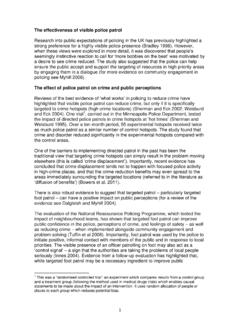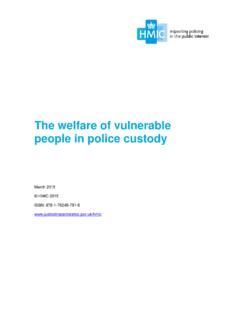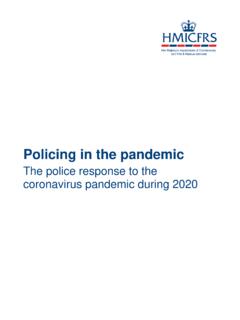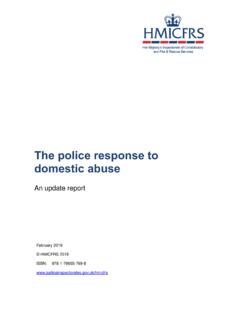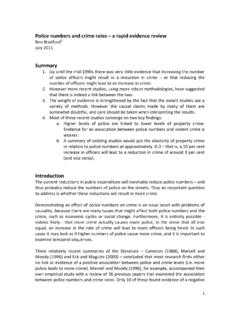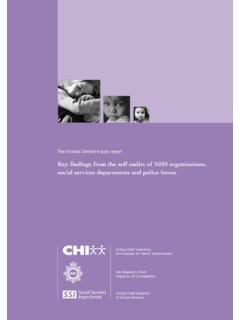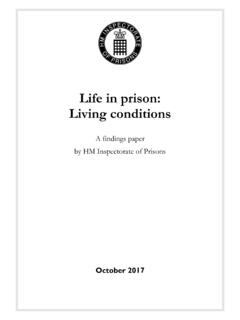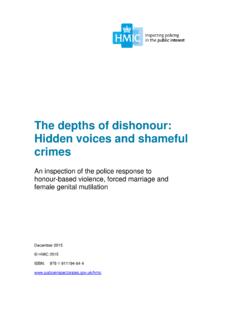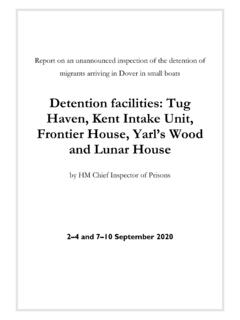Transcription of Living in fear the police and CPS response to harassment ...
1 Living in fear the police and CPS response to harassment and stalking A joint inspection by HMIC and HMCPSI. July 2017. HMIC 2017. ISBN: 978-1-78655-414-7. Contents Foreword .. 4. Summary .. 5. 1. Introduction .. 18. Background .. 18. About this 20. 2. Findings .. 22. Nature and context .. 22. Reporting and investigation .. 30. Risk identification and assessment .. 38. Risk management .. 42. police Information Notices .. 44. Victim care .. 49. Investigation .. 54. 3. Criminal justice process .. 60. Stalking Protection Orders .. 60. The national stalking protocol .. 62. Protecting victims during the criminal justice process .. 65. Case file quality .. 66. Restraining orders .. 70. Sentencing .. 77. Offender management .. 77. Offender 78. 4. Organisational problems .. 80. Leadership .. 80. Organisational understanding .. 80. 2. Awareness, guidance and training.
2 82. Stalking single points of contact .. 84. 5. 86. Recommendations .. 89. Definitions and interpretation .. 92. Annex A Methodology .. 104. Annex B HMIC harassment and stalking expert reference group .. 109. Annex C Protection orders flow chart .. 111. Annex D About the data .. 112. 3. Foreword You carry it all the time. You carry it and it's with you day in day out. Day in day out. And you breathe it, and it's in the back of your mind all the time, What is he going to do? What are we going to find Who's going to come knocking at our door?' . Stalking victim This is the first time that Her Majesty's Inspectorate of Constabulary and Her Majesty's Crown Prosecution Service Inspectorate have inspected and reported on the police service's and Crown Prosecution Service's approach to tackling crimes of harassment and stalking. harassment and stalking crimes are damaging and pervade all sections of society.
3 They can devastate lives and in some cases they end in death. In a digital world, they are crimes that can take place all too easily and frequently. They may be high-profile crimes and often gain the attention of the media when they affect public figures. However, the criminal justice system has a responsibility to all victims whatever the apparent level of seriousness of the actions complained about. Much has been done by government in recent years to try to improve how the criminal justice system tackles stalking in particular. Our inspection shows that actions taken have had mixed success. We now need to consider what more can be done to prevent crimes of harassment and stalking, to protect victims and to bring perpetrators to justice. We would like to record our very great appreciation for the contribution made to our work by the many victims and their representatives throughout this inspection.
4 We are grateful for the work of our expert reference group and also undertaken on our behalf by the University of Worcester, assisted by the Suzy Lamplugh We would like the voice of the victim to be heard through the content of this report. This report must be a catalyst for change and improvement: in some cases victims'. lives will depend on it. 1. For more information about the Suzy Lamplugh Trust, see: 4. Summary And you realise people who are under this kind of stress on a on a daily basis sometimes, I can understand how suicides occur. Because people feel that they don't know where to turn.. Stalking victim In 2016/17, Her Majesty's Inspectorate of Constabulary and Her Majesty's Crown Prosecution Service Inspectorate conducted a joint inspection of how the police and the Crown Prosecution Service tackle crimes of harassment and stalking. This report sets out our findings, and makes a series of recommendations aimed at improving police and CPS practice and therefore the service provided to victims.
5 Background harassment and stalking harassment and stalking are crimes of persistence. It is the unrelenting repeat behaviour by the perpetrator experienced in its totality, which seems inescapable and inevitable, that has such a detrimental effect on the victim. The actions in themselves may seem unremarkable, and this may partly explain why some victims suffer repeat behaviour over a prolonged period before reporting it to police ,2 or do not report it at all. harassment and stalking can often also be crimes of control. This is particularly the case when the victimisation is associated with a current or previous controlling and coercive relationship. A report by Dr Lorraine Sheridan and the Network for Surviving Stalking, in which 829 victims of stalking were surveyed, found that the victims were aged between 10. and 73. Men and women from all backgrounds were affected and many were professionals (38 percent).
6 Dr Sheridan concluded that almost anyone can become a victim of 2. Paper on Key findings from the , L. Sheridan, 2005. Data quoted in Introduction to stalking, risk & advocacy, Home Office, undated. Available from The findings state that 70 percent of victims do not report to the police until the hundredth incident. 3. Paper on Key findings from the , L. Sheridan, 2005. Data quoted in Introduction to stalking, risk & advocacy, Home Office, undated. Available from 5. In this inspection, we used the term stalking for behaviour that constituted harassment and where the perpetrator appeared to be fixated and/or obsessed with Legislation Under the Protection from harassment Act 1997, it is an offence for a person to pursue a course of conduct that amounts to harassment of another individual, and that they know (or ought to know) amounts to The Act defines harassment and states: References to harassing a person include alarming the person or causing the person distress.
7 6. A course of conduct' in the case of harassment of a single person must involve conduct on at least two occasions. The course of conduct in relation to two or more persons means conduct on at least one occasion in relation to each of those Before the introduction of stalking legislation, there was debate about the need to define stalking specifically in One concern raised was that being too prescriptive might limit unduly the application of the offence. As a result, section 2A(3) of the Protection from harassment Act 1997 instead gives examples of behaviours associated with stalking "in particular circumstances" (without detailing what these are). The list is not exhaustive but gives an indication of the types of behaviour that may be displayed in a stalking offence. Section 2A(2) of the Protection from harassment Act 1997 specifies when a person's course of conduct amounts to stalking of another person.
8 Main findings The findings below are the most significant and those where we believe positive changes will make the biggest difference to victims. Please read the full report for a complete picture of our findings, more extensive examples of good and poor practice, and word-for-word testimonies from victims who participated in our research project, which add context to the findings. 4. The terms fixated' and obsessed' are contained in Home Office circular 018/2012 A change to the Protection from harassment Act 1997: introduction of two new specific offences of stalking'. 5. Protection from harassment Act 1997, section 1. 6. Protection from harassment Act 1997, section 7(2). 7. Protection from harassment Act 1997, section 7(3). 8. Some of this debate is contained in the Independent Parliamentary Inquiry into Stalking Law Reform, Justice Unions' Parliamentary Group, February 2012.
9 6. Understanding and recognising stalking: problems with definitions There are many links between harassment and stalking, including the legislation However, we found that the police and the CPS frequently struggled to separate the two offences. We found that stalking in particular was misunderstood by the police and the CPS. As a result, it often went unrecognised. The police sometimes mis-recorded stalking offences, or worse, did not record them at all. Prosecutors on occasions missed opportunities to charge stalking offences, instead preferring other offences, particularly harassment . We also found that the absence of a single accepted, consistent definition of stalking is a very significant contributory factor to the unacceptably low number of recorded crimes and prosecutions. It is also one of the main reasons that police officers, staff and prosecutors gave us varying interpretations of stalking.
10 The result for victims was that offences were not dealt with appropriately by using stalking-specific powers (for example, the power to search premises and seize evidence).10 Incidents of victimisation were dealt with as isolated cases and were not treated seriously or quickly enough, and victims were left at risk. In some cases, the charges did not reflect the seriousness of the offending. There is not an exhaustive definition of stalking in legislation. This is one of the main reasons why there is a lack of common understanding about which actions can be counted as stalking. At present, identifying stalking is frequently a matter of subjectivity, which can lead to error and/or omission, as we found in our case file review. As a result, we consider the harassment and stalking legislation should be reviewed to ensure it is as effective as possible in protecting victims of stalking and bringing perpetrators to justice.
